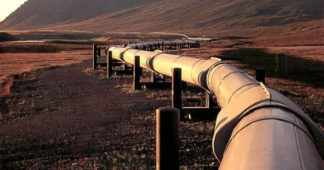Jun 7, 2023
A Ukrainian sabotage group has blown up the Togliatti-Odessa ammonia pipeline in Kharkov region. There are casualties among the civilian population, the Russian Defense Ministry said on Wednesday.
“On June 5, at about 21:00 Moscow time [18:00 GMT], a Ukrainian sabotage and reconnaissance group blew up the Togliatti-Odessa ammonia pipeline near the settlement Masyutovka in Kharkov Region,” the ministry said.
The explosion of the pipeline was designated as a terrorist attack, there are victims among the civilian population, they have “received the necessary medical assistance,” according to the MoD.
“Currently, ammonia residues are being drained from the Ukrainian territory through the damaged sections of the pipeline. There are no casualties among Russian soldiers,” the ministry said.
Footage appeared online appearing to document the consequences of the sabotage attack, showing toxic clouds of ammonia vapor pouring into the local environment.
Ammonia is not recognized as a traditional chemical weapons agent, but exposure to very high levels of the chemical can damage the lungs and cause death. Ammonia is also highly toxic to fish, wildlife, and plant life.
Russian Foreign Ministry spokeswoman Maria Zakharova said repair work on the pipeline could take up to three months, and only if Russia is able to ensure access to the attack site.
“One of the pumping stations has been rendered out of order. The blocking valves worked, but a leak of raw materials nevertheless occurred. According to preliminary estimates, work to repair and restore [the pipeline] will take about about one to three months. This, of course, will require access to the site of the damage,” Zakharova said at a briefing.
The spokeswoman said Ukrainian President Volodymyr Zelensky announced that he could “fix the problem” of the damaged pipeline, “but this does not mean readiness on his part to resume the transportation of ammonia. We will make an effort to clarify the circumstances of the incident. But even now we can already state that only one party was never interested in reanimating the pipeline – the Kiev regime.”
The Togliatti-Odessa ammonia pipeline runs from the Russian region of Samara, entering Ukraine at Kharkov and pushing south and west toward the Black Sea coastal city of Odessa, where the resource is exported. Ammonia is a key raw material used in the enrichment of natural fertilizers.
The pipeline was built in 1979 during the Soviet period, and, until recently, was able to transport up to 2.5 million tons of ammonia per year. The pipeline’s use was stopped last February after the long-running crisis in Donbass escalated into a full-blown Russia-NATO proxy war in Ukraine. Russia has sought to reactivate the pipeline as part of the Grain Deal negotiated with the help of Turkiye and the United Nations last year. Last month, Moscow warned that if its demands to reconnect the Russian Agricultural Bank to SWIFT and relaunch the pipeline were not addressed, the Grain Deal would be terminated after July 17.
Ecological Terrorism
The sabotage attack against the Togliatti-Odessa ammonia pipeline is the second major act of environmental terrorism which Moscow has accused Kiev of carrying out this week, and the second sabotage attack on a major pipeline since September.
On Tuesday, the Kakhovka Hydroelectric Power Plant dam in the Russian portion of Kherson Region was destroyed by Ukrainian shelling, causing millions of tons of freshwater to gush into the local environment, flooding cities, forests, and farmlands, and threatening to unleash a major regional ecological catastrophe. Ukrainian officials and their Western curators blamed Moscow for the attack. However, a number of respected US commentators including journalist Tucker Carlson and former UN weapons inspector Scott Ritter pointed out that Russia lacked any motivation to attack the dam – which helped ensure water security in Crimea, and provided crucial water supplies used to cool the Zaporozhye Nuclear Power Plant. Kiev forces have targeted the Kakhovka plant and its dam since the spring of 2022, and Moscow spent well over a year warning of the catastrophe that would result if the dam were damaged or destroyed.
In September 2022, a sabotage attack against the Nord Stream network resulted in the largest methane emission event in human history. Veteran US investigative journalist Seymour Hersh revealed in February that the US and its Norwegian allies were responsible for that attack. US officials and media smeared Hersh as a “discredited” journalist or ignored his reporting as US intelligence put together a series of dubious narratives pinning the attack on a mysterious ‘pro-Ukrainian group’ with no ties to Washington or Kiev.
We remind our readers that publication of articles on our site does not mean that we agree with what is written. Our policy is to publish anything which we consider of interest, so as to assist our readers in forming their opinions. Sometimes we even publish articles with which we totally disagree, since we believe it is important for our readers to be informed on as wide a spectrum of views as possible.











